The Role of Big Data Analytics in Smart Cities
In today's fast-paced urban environments, the integration of big data analytics is not just a trend; it's a necessity. As cities grow and evolve, so do the challenges associated with managing them. Here, big data acts as a beacon of hope, illuminating pathways to enhanced efficiency, sustainability, and quality of life. Imagine a city where traffic flows smoothly, energy consumption is optimized, and services are tailored to the needs of its residents—this vision is made possible through the insightful use of data.
Big data analytics enables city planners and administrators to make informed decisions that directly impact urban living. By harnessing vast amounts of data collected from various sources, cities can identify patterns, predict outcomes, and allocate resources more effectively. This leads to a more responsive urban ecosystem, where the needs of the population are met with precision and foresight.
One of the most compelling aspects of big data in smart cities is its ability to drive innovation. From healthcare to transportation, data analytics serves as the backbone of numerous initiatives aimed at improving urban life. For instance, consider how predictive analytics can forecast traffic congestion, allowing for real-time adjustments that keep the flow of vehicles moving smoothly. Or think about how energy consumption data can lead to smarter grids that utilize renewable resources more efficiently. The possibilities are virtually endless, and they all converge on the idea of creating a more livable urban environment.
Moreover, the role of big data analytics extends beyond mere management; it fosters a culture of collaboration among city stakeholders. By sharing data, city officials, businesses, and residents can work together to tackle common challenges. This collaborative approach not only enhances transparency but also builds trust within the community. Imagine a scenario where citizens can access real-time information about public services or report issues directly to city officials through an app—this is the power of big data in action.
However, the journey towards becoming a smart city is not without its hurdles. As cities increasingly rely on data, they must navigate the complexities of data privacy and security. Ensuring that citizens' information is protected while still leveraging data for public good is a balancing act that requires careful planning and robust policies. It is essential for city leaders to address these concerns proactively, fostering a safe environment for innovation.
In summary, big data analytics is reshaping the landscape of urban living. It empowers city officials to enhance services, improve resource management, and engage with residents in meaningful ways. As we move forward, the question remains: how can we harness the full potential of big data to create smarter, more resilient cities? The answer lies in continuous innovation, collaboration, and a commitment to addressing the challenges that come with this powerful tool.
- What is big data analytics? Big data analytics refers to the process of examining large and varied data sets to uncover hidden patterns, correlations, and other insights that can help in decision-making.
- How does big data improve urban living? It enhances urban living by optimizing resources, improving public services, and enabling better decision-making for city planners.
- What are some examples of big data applications in smart cities? Examples include traffic management systems, waste management optimization, and energy consumption analysis.
- What challenges does big data pose for smart cities? Challenges include data privacy concerns, security risks, and the need for effective data governance.

Understanding Big Data in Urban Contexts
Big data is a term that has become increasingly prevalent in discussions about urban development and management. But what exactly does it mean in the context of our cities? Simply put, big data refers to the enormous volumes of information generated from various sources within urban environments. This data can come from a multitude of channels, including traffic sensors, social media interactions, and even public transportation systems. The significance of big data lies not just in its sheer volume, but in its potential to transform the way we plan, manage, and experience urban life.
Imagine walking through a bustling city. Every step you take, every tweet you send, and every ride you take on the subway contributes to a vast pool of data. This information can be analyzed to uncover patterns and trends that were previously invisible. For instance, city planners can use this data to identify peak traffic times, allowing them to optimize traffic signals and reduce congestion. In essence, big data serves as a digital mirror reflecting the behaviors, preferences, and needs of urban residents.
But the impact of big data extends far beyond traffic management. It plays a crucial role in various aspects of urban living, including public safety, healthcare, and environmental sustainability. Cities can leverage data analytics to predict crime hotspots, allocate emergency services more effectively, and even monitor air quality. By harnessing the power of big data, city officials can make informed decisions that enhance the quality of life for residents. Here are some key areas where big data is making a difference:
- Urban Planning: Analyzing demographic data helps in designing better housing and public spaces.
- Resource Management: Data-driven insights lead to more efficient use of water, energy, and waste management systems.
- Public Health: Tracking health trends allows for timely interventions and improved healthcare services.
Moreover, the integration of big data into urban contexts fosters a culture of innovation and collaboration. By sharing data across different sectors—such as transportation, healthcare, and public safety—cities can create comprehensive solutions that address multiple challenges simultaneously. For example, when transportation data is combined with health data, cities can better understand how urban design affects public health outcomes, leading to initiatives that promote walking and cycling.
In conclusion, understanding big data in urban contexts is not just about the numbers; it’s about the stories they tell and the potential they hold for creating smarter, more efficient cities. As urban areas continue to grow and evolve, the ability to harness and analyze big data will be essential for ensuring that our cities remain livable, sustainable, and responsive to the needs of their residents.

Data Collection Methods for Smart Cities
In the rapidly evolving landscape of urban environments, data collection is the backbone of smart city initiatives. Various methods are employed to gather vast amounts of data from diverse sources, allowing cities to make informed decisions that enhance the quality of life for their residents. But what exactly are these methods, and how do they contribute to a smarter urban experience? Let's dive into the world of data collection in smart cities.
One of the most prominent methods of data collection in smart cities is through the use of Internet of Things (IoT) devices. These devices, which can range from smart traffic lights to environmental sensors, continuously collect and transmit data. For instance, a network of sensors can monitor air quality, providing real-time feedback that helps city planners address pollution issues. In fact, the integration of IoT into urban infrastructure can lead to significant improvements in resource management, making cities not just smarter, but also more sustainable.
Additionally, social media has emerged as an unconventional yet effective data source. Platforms like Twitter and Facebook can provide valuable insights into public sentiment and behavior. By analyzing posts and interactions, city officials can gauge the needs and concerns of residents, allowing for more responsive governance. Imagine a city that can adapt its services based on real-time feedback from its citizens—this is the power of social media data!
Another essential method is the deployment of surveillance cameras equipped with advanced analytics. These cameras do more than just monitor; they analyze traffic patterns, crowd movements, and even detect anomalies. The data collected can be used to optimize traffic flow, enhance public safety, and improve emergency response times. However, this method raises important questions about privacy and the ethical use of surveillance data.
| Data Collection Method | Description | Benefits |
|---|---|---|
| IoT Devices | Connected devices that gather real-time data. | Improved resource management and sustainability. |
| Social Media | Data from platforms to understand public sentiment. | Responsive governance and community engagement. |
| Surveillance Cameras | Cameras that analyze traffic and crowd behavior. | Enhanced public safety and optimized traffic flow. |
Moreover, mobile applications have become a vital tool for data collection. Many cities encourage residents to use apps that report issues such as potholes or broken streetlights. This not only empowers citizens to take an active role in their community but also provides city officials with a wealth of data on where resources are needed most. It's like having a direct line to the city's maintenance team, ensuring that problems are addressed promptly.
Lastly, geographic information systems (GIS) play a crucial role in visualizing data. By mapping out various data points, cities can identify trends and patterns that may not be immediately obvious. For example, GIS can reveal which neighborhoods experience higher rates of traffic accidents, prompting targeted safety measures. This spatial analysis is essential for effective urban planning and resource allocation.
As we can see, the methods of data collection in smart cities are diverse and multifaceted. Each technique brings its own set of advantages, contributing to a comprehensive understanding of urban dynamics. The synergy of these methods creates a robust framework for informed decision-making, ultimately leading to improved urban living. But with great data comes great responsibility—cities must navigate the challenges of data privacy and security as they embrace these innovative technologies.
- What is the role of IoT in smart cities? IoT devices collect and transmit real-time data that helps improve resource management and urban planning.
- How does social media contribute to data collection? Social media provides insights into public sentiment, allowing city officials to respond more effectively to residents' needs.
- What are the privacy concerns associated with data collection? The use of surveillance cameras and data analytics raises questions about how citizens' information is used and protected.

The Internet of Things (IoT) Impact
The Internet of Things, commonly referred to as IoT, is revolutionizing the way we interact with our urban environments. Imagine a city where everything from traffic lights to waste bins is interconnected, communicating data in real-time to enhance efficiency and improve the quality of life for its residents. This is not just a futuristic dream; it's happening right now in smart cities across the globe. The impact of IoT on urban living is profound, as it enables cities to collect massive amounts of data, which can be analyzed to make informed decisions.
One of the most significant advantages of IoT is its ability to provide real-time insights into city operations. For instance, consider smart traffic lights that adjust their timings based on current traffic conditions. By utilizing sensors and cameras, these systems can detect the flow of vehicles and alter light patterns accordingly. This not only reduces congestion but also minimizes travel time, making commutes less frustrating for drivers. The integration of IoT in transportation is just one example of how data can transform urban mobility.
Furthermore, IoT devices play a critical role in enhancing public safety. Smart surveillance cameras equipped with facial recognition technology can monitor public spaces and alert authorities to suspicious activities in real-time. This proactive approach to security can significantly reduce crime rates and create a safer environment for residents. Additionally, IoT-enabled emergency response systems can streamline communication during crises, ensuring that help arrives quickly when it's needed most.
Data collected through IoT devices also contributes to better resource management. For example, smart water meters can detect leaks and monitor consumption patterns, allowing cities to conserve water and reduce waste. Similarly, smart waste management systems can optimize collection routes based on real-time data about bin fill levels, saving time and fuel costs. This level of efficiency is not only beneficial for the environment but also for the city’s budget.
As we explore the impact of IoT on smart cities, it’s essential to recognize the importance of interoperability. For IoT systems to function effectively, various devices and platforms must communicate seamlessly. This requires robust infrastructure and standards that facilitate data sharing across different systems. When implemented correctly, the synergy between IoT devices can lead to a smarter, more responsive urban ecosystem.
However, with great power comes great responsibility. As cities embrace IoT technologies, they must also address the privacy and security concerns that arise from collecting vast amounts of data. Citizens need assurance that their personal information is protected and that data collected from IoT devices is used ethically. Establishing clear guidelines and robust cybersecurity measures is crucial to maintaining public trust in these technologies.
In conclusion, the impact of the Internet of Things on smart cities is transformative. By harnessing the power of real-time data, cities can enhance transportation, improve public safety, and optimize resource management. As we continue to innovate and integrate IoT into urban planning, the potential for creating more livable, efficient, and sustainable cities is limitless. The future of urban living is not just about technology; it’s about creating environments where data-driven decisions lead to improved quality of life for everyone.
- What is the Internet of Things (IoT)?
IoT refers to a network of interconnected devices that communicate and exchange data with each other, often without human intervention. - How does IoT improve urban living?
IoT enhances urban living by providing real-time data that helps optimize transportation, improve public safety, and manage resources more efficiently. - What are the privacy concerns associated with IoT?
Privacy concerns include the potential for unauthorized access to personal data collected by IoT devices, making it essential for cities to implement strong security measures. - Can IoT help reduce traffic congestion?
Yes, IoT technologies can optimize traffic flow by adjusting traffic signals based on real-time data, thus reducing congestion and travel times.

Smart Transportation Systems
Imagine a world where your daily commute is not just a routine but a seamless experience, where traffic jams are a thing of the past, and public transport runs like clockwork. This is the promise of , powered by big data analytics. By harnessing real-time data, cities can optimize traffic flow, reduce congestion, and enhance overall mobility. But how does this actually work?
At the heart of smart transportation systems lies the ability to collect and analyze vast amounts of data from various sources. This includes information from traffic sensors, GPS devices, and even social media platforms where commuters share their experiences. By aggregating this data, city planners can gain invaluable insights into traffic patterns, peak travel times, and even potential hazards on the road.
For instance, consider a city where traffic lights are connected to a central system that analyzes real-time traffic conditions. When a major event occurs, such as a concert or a sports game, the system can adjust traffic light timings to accommodate the influx of vehicles, ensuring smoother flows and reducing wait times. This dynamic response not only enhances the commuting experience but also significantly lowers emissions by minimizing idling time.
Moreover, smart transportation systems extend beyond just managing traffic. They also play a crucial role in public transport. By integrating data from bus and train schedules with real-time passenger information, cities can provide commuters with accurate arrival times and alternative routes. Imagine being able to receive a notification on your smartphone that your bus is running late, along with suggestions for alternative routes or modes of transport. This level of convenience is made possible through big data analytics.
Another exciting development is the rise of autonomous vehicles. These vehicles rely heavily on data analytics to navigate safely and efficiently. With the ability to communicate with each other and the surrounding infrastructure, they can react to changing conditions, such as sudden stops or accidents, thereby enhancing safety and reducing traffic incidents. In fact, studies have shown that the widespread adoption of autonomous vehicles could lead to a significant decrease in traffic accidents, ultimately saving lives.
However, the implementation of smart transportation systems is not without challenges. Cities must invest in the necessary infrastructure, including data collection devices and communication networks. Additionally, public acceptance of new technologies plays a critical role in their success. As cities move towards smarter transportation solutions, it is essential to engage with the community, addressing any concerns and educating the public about the benefits of these systems.
| Benefits of Smart Transportation Systems | Impact |
|---|---|
| Reduced Congestion | Improved travel times and reduced fuel consumption |
| Enhanced Safety | Lower accident rates through real-time data sharing |
| Environmental Benefits | Decreased emissions and improved air quality |
| Informed Decision Making | Data-driven policies leading to better urban planning |
In conclusion, smart transportation systems represent a transformative shift in how we navigate urban environments. By leveraging big data analytics, cities can create a more efficient, safer, and user-friendly transportation landscape. As we continue to embrace these innovations, the future of urban mobility looks brighter than ever.
- What is a smart transportation system?
A smart transportation system uses technology and data analytics to improve the efficiency and safety of transportation networks. - How does big data contribute to transportation?
Big data helps analyze traffic patterns, optimize routes, and enhance public transport schedules, leading to improved mobility. - Are autonomous vehicles part of smart transportation systems?
Yes, autonomous vehicles rely on data analytics to navigate and communicate with other vehicles and infrastructure. - What are the main benefits of smart transportation systems?
Benefits include reduced congestion, enhanced safety, environmental improvements, and informed decision-making for urban planning.

Waste Management Optimization
In today's rapidly urbanizing world, effective waste management has become a pressing concern for cities around the globe. With the increasing population, the volume of waste generated is skyrocketing, leading to challenges in disposal and recycling. This is where big data analytics steps in, revolutionizing the way cities approach waste management. By leveraging vast amounts of data collected from various sources, cities can optimize their waste collection processes, reduce operational costs, and enhance sustainability.
Imagine a city where garbage trucks only visit areas that need collection, significantly reducing fuel consumption and operational costs. This is not a distant dream but a reality made possible through data analytics. By analyzing data from IoT sensors placed in waste bins, cities can monitor fill levels in real-time, enabling them to schedule pickups more efficiently. This not only saves time and resources but also minimizes the carbon footprint associated with waste collection.
Moreover, big data analytics can help cities identify patterns in waste generation. By examining historical data, urban planners can predict peak waste generation times and adjust collection schedules accordingly. For instance, if a neighborhood generates more waste during weekends due to local events, the city can proactively increase collection frequency during those times. This predictive capability ensures that waste does not accumulate, leading to cleaner streets and improved public health.
Additionally, integrating social media sentiment analysis into waste management strategies can provide valuable insights. By monitoring public feedback regarding waste services, cities can pinpoint areas needing improvement. For example, if residents frequently complain about missed pickups in a particular district, city officials can take immediate action to address these issues, thus fostering a sense of community trust and engagement.
| Benefits of Big Data in Waste Management | Impact |
|---|---|
| Real-time monitoring | Efficient resource allocation and reduced costs |
| Predictive analytics | Proactive waste management and improved service delivery |
| Public engagement | Enhanced community trust and satisfaction |
Furthermore, cities can employ data analytics to improve recycling rates. By analyzing demographic data and waste composition, urban planners can tailor educational campaigns to encourage recycling in specific neighborhoods. For example, if a particular area has low recycling rates, targeted initiatives can be implemented to raise awareness about the importance of recycling and provide information on proper disposal methods.
In conclusion, the integration of big data analytics into waste management systems is not just a trend; it's a necessity for modern cities striving for sustainability and efficiency. As cities continue to grow, optimizing waste management through data-driven strategies will play a crucial role in enhancing urban living and protecting the environment.
Q1: How does big data improve waste management?
Big data improves waste management by enabling real-time monitoring, predictive analytics, and targeted community engagement, leading to more efficient resource allocation and higher recycling rates.
Q2: What technologies are used in smart waste management?
Technologies include IoT sensors for monitoring waste levels, data analytics platforms for processing information, and mobile applications for community engagement and reporting issues.
Q3: Can big data help reduce the carbon footprint of waste collection?
Yes, by optimizing collection routes and schedules based on real-time data, cities can significantly reduce fuel consumption and emissions associated with waste collection.

Data Privacy and Security Concerns
As cities embrace the transformative power of big data analytics, the topic of data privacy and security becomes increasingly critical. With vast amounts of information being collected from citizens, vehicles, and infrastructure, it’s essential to consider how this data is managed and protected. Imagine living in a city where every movement you make is tracked—while this can lead to improved services, it also raises significant questions about who has access to this data and how it is being used.
One of the primary concerns is the potential for data breaches. Cybersecurity threats are constantly evolving, and as cities become more interconnected through the Internet of Things (IoT), the risk of unauthorized access increases. For instance, if a city's traffic management system is hacked, it could lead to chaos on the roads, endangering lives and disrupting daily commutes. Therefore, cities must invest in robust cybersecurity measures to safeguard sensitive information.
Moreover, there is the issue of informed consent. Citizens often remain unaware of the extent of data collection and its implications. Transparency is key; cities should ensure that residents are fully informed about what data is being collected, how it will be used, and the measures in place to protect their privacy. This can be achieved through public forums, informative campaigns, and user-friendly privacy policies.
Additionally, the ethical use of data is paramount. Cities must establish clear guidelines that dictate how data can be utilized. For example, while data can help improve public services, it should not be used for surveillance or profiling without consent. The balance between leveraging data for innovation and respecting individual privacy rights is a delicate one that requires ongoing dialogue and regulatory oversight.
To further illustrate the importance of data privacy, consider the following table that outlines some common threats and recommended protective measures:
| Threat | Recommended Measures |
|---|---|
| Data Breaches | Implement strong encryption and regular security audits. |
| Unauthorized Access | Use multi-factor authentication and access controls. |
| Informed Consent Issues | Enhance transparency through public engagement and clear policies. |
| Ethical Misuse of Data | Establish guidelines and ethical frameworks for data use. |
In conclusion, while big data analytics holds immense potential for enhancing urban living, it is crucial for cities to prioritize data privacy and security. By addressing these concerns proactively, cities can build trust with their citizens and ensure that the benefits of smart city initiatives are realized without compromising individual rights.
- What is big data in the context of smart cities? Big data refers to the vast amounts of information generated from various urban sources, which can be analyzed for better decision-making and resource management.
- How can cities ensure data privacy? Cities can ensure data privacy by implementing strong cybersecurity measures, enhancing transparency, and establishing ethical guidelines for data usage.
- What are the risks associated with big data analytics? The risks include data breaches, unauthorized access, and ethical misuse of data, all of which can jeopardize citizen privacy and safety.
- How does big data improve urban living? Big data improves urban living by optimizing resource management, enhancing public services, and enabling informed decision-making for city planners.

Case Studies of Successful Smart Cities
Examining successful smart cities worldwide provides us with invaluable insights into best practices and lessons learned. These cities have harnessed the power of big data analytics to enhance urban living, streamline processes, and create more sustainable environments. Let's take a closer look at a couple of exemplary cities that have made significant strides in this domain.
Barcelona stands as a beacon of innovation, showcasing how big data can transform urban life. The city has implemented an array of smart initiatives that leverage data analytics to improve public services and enhance the quality of life for its residents. Through the integration of IoT devices and data collection methods, Barcelona has been able to monitor everything from traffic patterns to energy consumption in real-time.
One of the standout features of Barcelona's smart city strategy is its smart lighting system, which adjusts brightness based on pedestrian and vehicle presence. This not only reduces energy consumption but also enhances public safety. Furthermore, the city utilizes data analytics to optimize waste management processes, ensuring that garbage collection is efficient and timely. By analyzing waste generation patterns, the authorities can deploy resources where they are needed most, significantly reducing operational costs and environmental impact.
On the other side of the globe, Singapore's Smart Nation initiative illustrates the profound impact of big data on urban development. The city-state has embraced a comprehensive approach to becoming a smart nation, integrating technology into every facet of urban life. From transportation to healthcare, data analytics plays a pivotal role in shaping policies and services.
One of the key components of Singapore's strategy is its smart transportation system. By utilizing real-time data from various sources such as GPS, traffic cameras, and public transportation systems, Singapore has developed an intelligent traffic management system that minimizes congestion and enhances travel efficiency. This system not only improves the daily commute for residents but also contributes to a significant reduction in carbon emissions.
Moreover, Singapore has implemented a robust framework for data governance, ensuring that citizens' privacy is protected while maximizing the benefits of data analytics. This balance between innovation and security serves as a model for other cities aiming to adopt similar technologies.
Both Barcelona and Singapore exemplify how cities can leverage big data analytics to drive innovation and improve urban living. Here are some key takeaways:
- Integration of IoT: Smart cities utilize IoT devices to collect real-time data, enabling informed decision-making.
- Efficiency in Public Services: Data analytics helps optimize public services like transportation and waste management, leading to cost savings and improved service delivery.
- Data Governance: Establishing a strong framework for data privacy and security is crucial for building trust among citizens.
These case studies not only highlight the potential of big data in urban management but also inspire other cities to embark on their own smart city journeys.
What is a smart city?
A smart city uses digital technology to enhance performance, reduce costs, and improve the quality of life for its residents. By leveraging big data, cities can optimize resources and services.
How does big data benefit smart cities?
Big data allows cities to make informed decisions, improve public services, and enhance resource management. It plays a crucial role in areas like transportation, waste management, and energy efficiency.
What are some challenges faced by smart cities?
Challenges include data privacy concerns, the need for robust infrastructure, and ensuring that technology is accessible to all citizens. Addressing these issues is vital for the successful implementation of smart city initiatives.

Barcelona: A Model for Smart Urban Living
Barcelona has emerged as a shining example of how big data analytics can transform urban living, making it more efficient, sustainable, and enjoyable for its residents. The city has embraced technology not just as a tool, but as a foundation for innovation in urban planning and management. One of the primary drivers of this transformation is the city's commitment to using data to enhance the quality of life for its citizens. By harnessing the power of big data, Barcelona has set a benchmark for other cities striving to become smart urban environments.
At the heart of Barcelona's smart city initiatives is the Barcelona Smart City Strategy, which focuses on integrating technology into various aspects of urban life. The city collects vast amounts of data from numerous sources, including IoT sensors, public transport systems, and environmental monitoring tools. This data is then analyzed to inform decision-making processes, ensuring that resources are allocated efficiently and effectively. For instance, by monitoring traffic patterns and public transport usage, city planners can make real-time adjustments to improve accessibility and reduce congestion.
One of the standout features of Barcelona's smart city approach is its emphasis on citizen engagement. The city actively involves residents in the data collection process through mobile applications and online platforms, allowing them to report issues like potholes or broken streetlights. This not only empowers the community but also enhances the city's responsiveness to its residents' needs. By creating an ecosystem where data flows freely between the city and its inhabitants, Barcelona fosters a sense of ownership and collaboration in urban development.
Moreover, Barcelona's initiatives extend to sustainability efforts. The city has implemented data-driven solutions to tackle environmental challenges, such as air quality monitoring and waste management optimization. For example, smart bins equipped with sensors notify waste management services when they are full, ensuring timely collection and reducing overflow. This not only keeps the city clean but also promotes recycling and waste reduction efforts, aligning with global sustainability goals.
To further illustrate the impact of big data analytics on Barcelona's urban living, consider the following table that highlights some of the key initiatives and their outcomes:
| Initiative | Description | Outcome |
|---|---|---|
| Smart Traffic Management | Real-time monitoring of traffic flow using sensors and cameras. | Reduced congestion by 20% during peak hours. |
| Smart Waste Management | IoT-enabled bins that signal when they need to be emptied. | Increased recycling rates by 15% and reduced operational costs. |
| Public Transport Optimization | Data analytics to improve bus and metro schedules based on demand. | Increased public transport usage by 30%. |
In conclusion, Barcelona serves as a remarkable model for smart urban living, showcasing how big data analytics can drive innovation and enhance the quality of life. By prioritizing data-driven decision-making and fostering community engagement, the city not only addresses immediate urban challenges but also lays the groundwork for sustainable growth. As other cities look to Barcelona for inspiration, it becomes clear that the integration of technology and data in urban planning is not just a trend, but a necessity for the cities of the future.
- What makes Barcelona a smart city? Barcelona utilizes big data analytics to improve urban management, enhance sustainability, and engage citizens in decision-making processes.
- How does Barcelona collect data? The city employs various methods, including IoT sensors, public transport systems, and citizen reports via mobile apps.
- What are some outcomes of Barcelona's smart city initiatives? Notable outcomes include reduced traffic congestion, increased recycling rates, and improved public transport efficiency.

Singapore's Smart Nation Initiative
Singapore's Smart Nation initiative is a groundbreaking approach to urban living that leverages the power of big data analytics to enhance the quality of life for its citizens. Launched in 2014, this initiative aims to transform Singapore into a leading smart city by integrating technology into various aspects of daily life, from transportation to healthcare. Imagine a city where everything is interconnected, where data flows seamlessly to improve services and make informed decisions—this is the vision that Singapore is bringing to life.
At the heart of the Smart Nation initiative lies the Internet of Things (IoT), which enables the collection of real-time data from a wide array of sources, including sensors, smart devices, and even social media platforms. This data is not just a collection of numbers; it is a treasure trove of insights that can drive innovation and efficiency. For instance, the city has deployed thousands of sensors throughout its urban landscape to monitor everything from traffic patterns to environmental conditions. This allows city planners to make data-driven decisions that enhance urban management and resource allocation.
One of the most notable applications of big data in Singapore is in the area of smart transportation systems. By analyzing traffic data in real-time, the city has been able to optimize traffic flow and reduce congestion significantly. Imagine being able to predict traffic jams before they happen and rerouting vehicles accordingly—this is precisely what Singapore is achieving through its advanced analytics capabilities. The integration of public transport data with private vehicle data allows for a more cohesive and efficient transportation network, ultimately leading to a smoother commute for everyone.
Moreover, the Smart Nation initiative has also made strides in waste management optimization. By utilizing data analytics, Singapore can monitor waste generation patterns and optimize collection routes. This not only saves time and resources but also promotes sustainability by improving recycling efforts. The city has implemented smart bins equipped with sensors that notify waste management services when they are full, ensuring timely collection and reducing overflow.
However, with great power comes great responsibility. As Singapore embraces the digital transformation, data privacy and security have become paramount concerns. The government has established stringent measures to protect citizens' data, ensuring that privacy is maintained while still benefiting from the insights that big data provides. This includes robust cybersecurity protocols and transparent data usage policies that build trust among the populace.
In conclusion, Singapore's Smart Nation initiative exemplifies how big data analytics can be harnessed to create a more efficient and livable urban environment. By focusing on innovation and citizen engagement, Singapore is not just preparing for the future; it is actively shaping it. As other cities look to Singapore as a model, the lessons learned from this initiative will undoubtedly influence the next generation of smart cities worldwide.
- What is the Smart Nation initiative? The Smart Nation initiative is Singapore's comprehensive plan to integrate technology and data analytics into urban living to improve the quality of life for its citizens.
- How does big data play a role in smart cities? Big data helps cities make informed decisions by analyzing vast amounts of information collected from various sources, leading to improved resource management and urban planning.
- What are some challenges associated with big data in urban environments? Key challenges include data privacy concerns, cybersecurity threats, and the need for robust infrastructure to support data collection and analysis.
Frequently Asked Questions
- What is big data in the context of smart cities?
Big data refers to the enormous volumes of data generated from various urban sources, such as sensors, social media, and IoT devices. In smart cities, this data is crucial for enhancing urban living, as it helps in informed decision-making and efficient resource management.
- How is data collected in smart cities?
Data in smart cities is collected through various methods, including IoT devices, sensors placed throughout the urban landscape, and social media interactions. These methods allow cities to gather real-time information on traffic, waste management, and public sentiment, which is vital for effective urban planning.
- What role does the Internet of Things (IoT) play in smart cities?
The IoT is a game changer for smart cities as it generates real-time data that can be analyzed to improve urban services. For instance, smart traffic lights can adjust based on traffic flow, and waste bins can signal when they need to be emptied, leading to more efficient city operations.
- How does big data analytics improve transportation systems?
Big data analytics enhances transportation systems by optimizing traffic flow and reducing congestion. By analyzing data from various sources, cities can implement smart traffic management solutions that adjust signals and reroute traffic in real-time, making commutes smoother for everyone.
- What are the privacy and security concerns related to big data in smart cities?
As cities adopt big data solutions, privacy and security concerns arise, particularly regarding the protection of citizens' personal information. It is essential for city planners to implement robust data security measures and policies to ensure that citizen data is handled responsibly and ethically.
- Can you provide examples of successful smart cities?
Yes! Cities like Barcelona and Singapore are leading examples of successful smart cities. Barcelona utilizes big data for urban management, enhancing public services and citizen engagement, while Singapore’s Smart Nation initiative employs comprehensive data strategies to improve the quality of life for its residents.



















